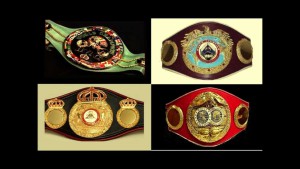Multiple World Title Belts & Champions: A Scathing Commentary!
 By Roy “Sharpshooter” Bennett
By Roy “Sharpshooter” Bennett
Titles, baubles, and trinkets. Throughout the ages fighters and their supporters have been enamored with them. From the laurel wreaths placed upon the heads of the Olympic champions of ancient times, the silver belt given to England’s bareknuckle Heavyweight Champion Tom Cribb for beating Jem Belcher in 1809, and the gold belt given to John L. Sullivan in 1889 as a gift from his supporters to identify him – from a rival claimant to the title – as the real world Heavyweight Champion, to the garish straps in circulation today, the championship belt signifies the fighter as the “The Man” who beat “The Man”. But in today’s game where we’re forced to put up with having as many as 4 ‘world champions’ in most weight divisions, the old saying, “All that glitters is not necessarily gold,” seems more true than ever.
Boxing has gone from the traditional 8 weight classes with one champion in each division, to 17 weight classes with up to 4 champions in each division. That’s 68 boxers walking around claiming to be a “World Champion” when there are at least 3 other boxers at the same weight claiming the same thing. So how did this ridiculous situation come about? Some history is in order to explain the state of the game today.
The National Boxing Association (NBA) was founded in 1921 and was one of the first boxing governing bodies of its kind in America. In previous years the reigning Heavyweight Champion, upon retirement, could announce his choice of two fighters who would battle for the right to succeed him as champion. For example, Jim J. Jeffries – king of the big men – selected Marvin Hart to fight Jack Root in 1905 to determine who would be his successor. Hart won by knockout in 12 rounds and was proclaimed as the new champion.
Marvin Hart would go on to lose the title in the ring to Tommy Burns, in 1906 in Los Angeles, via decision over twenty rounds. Burns took the championship and a purse of $15,000. Former heavyweight champ Jim J. Jeffries was the referee. Burns would lose the title to Jack Johnson in fourteen one sided rounds in Sydney, Australia, on Boxing Day, 1908, when the police intervened to stop the fight and save Burns from further punishment. Johnson would eventually lose the title to Jess Willard by knockout in twenty six rounds, in Havana, Cuba in 1915, and Willard would suffer a brutal beating in losing the title to Jack Dempsey in three savage rounds in 1919 in Toledo, Ohio. I recount all of this to chart the course of the lineal world heavyweight championship before it became fragmented under the auspices of numerous governing bodies in later years.
Dempsey’s title defense against the Frenchman Georges Carpentier, in New Jersey in 1921, became the first ever title fight sanctioned by the NBA. The new governing body was composed of 15 American States. New York and Massachusetts were the only states where professional boxing was conducted which were not members of the NBA.
New York had its own highly-influential New York State Athletic Commission (NYSAC). But more on that later. The NBA would eventually go on to become the World Boxing Association (WBA) in 1962 and move its offices from the U.S. to Panama, then to Caracas, Venezuela, then back to Panama.
For New York the turning point for the sport to gain mass popular support was the arrival on the pugilistic scene of a charismatic, big punching, young pugilist who went by the name of John L. Sullivan. He became an extraordinarily popular figure in the late nineteenth century, a living icon whose prowess in the squared circle brought him lasting fame and career ring earnings of a million dollars, a huge amount for the time. From an early age, Sullivan showed great proficiency with his fists. As a young man, he would fight in Boston barrooms, issuing a challenge that he could “lick any man in the house.”
In 1881 Sullivan came to New York and took on the battle hardened John Flood, aka the “Bulls Head Terror”, and battered him to a knockout defeat in 8 bloody rounds. The bout took place on a barge on the Hudson River so the fighters and their followers could evade any attempt by the authorities to stop the fight from taking place. Both fighters wore tight, unpadded gloves.
In 1882 Sullivan met Paddy Ryan, the Heavyweight Champion – at least in American eyes – in Mississippi City, Mississippi. Sullivan dominated the fight and knocked Ryan out in the eighth round.
Sullivan was now considered the world champion, although there was some disagreement among British and Australian followers of the sport. Bareknuckle prizefighting was illegal at this time in New York State. But Sullivan’s emergence, vast renown, and charismatic style did much to advance the sport of boxing in America which would eventually lead to its formal legalization. Sullivan’s significance to the sport at this time cannot be overstated. Over the next few years he would become the face of boxing in the U.S. and introduce gloved fighting as a more socially acceptable version of the sport that would be further developed under the Marquis of Queensbury Rules, written by John Graham Chambers, a member of the British Amateur Athletic Club, in 1862.
From 1900-1911 New York State implemented the no decision rule. This meant the only way to get a win on your record was by stopping your opponent inside the scheduled distance. As there was no judging allowed at the end of a contest it was ruled a No Decision. However, newspapers of the time reported their own winners, and so there exists an unofficial ledger of fight results for boxing historians, record keepers and fans to assess the success of fighters from this period in boxing’s history. But, unsurprisingly, the no decision rule was unappealing. In 1911 the Frawley Act was implemented and would last for 6 years. No decision bouts were still in existence, mandated under the act itself, but the maximum bout length during the time of the act was 10 rounds.
With the passage of the Walker Act in 1920, boxing became legal in the state of New York under the jurisdiction of the New York State Athletic Commission. The NYSAC would crown their own world champions, just like the NBA, and so began the championship mess of more than one boxer holding ‘world champion’ status at the same weight.
The NYSAC would go on to support the formation of the World Boxing Council (WBC) in 1963. In the ongoing power struggle between the NBA and the NYSAC, disputes over the real champion in a given weight class were often settled by Nat Fleischer, editor of Ring Magazine. Under Fleischer’s authority, the magazine issued monthly rankings of contenders and awarded its own championship belts.
Predictably, the WBA and WBC would also crown different champions in the same weight divisions. In the 1970’s and 80’s both organizations would further add to the confusion by doubling the number of weight classes, adding to the panoply of champions. The International Boxing Federation (IBF) emerged in 1983 as the result of a power struggle within the ranks of the WBA. A failed power grab by Bob Lee, head of the United States Boxing Association (USBA) led to the formation of the IBF. Another seventeen ‘world titles’ were now on offer. The World Boxing Organization (WBO) was another break away faction from the gilded hallways of the WBA. The WBO, of course, recognizes its own “world titles” and champions in the seventeen weight divisions.
Nowadays some boxing fans like to talk about the business side of the sport more than the actual boxing. They say boxing is the entertainment business. Boxing’s governing alphabet bodies would certainly agree. They’ve been ripping fighters off for decades and giving fans lots to laugh about with their blatantly corrupt practices and utterly ridiculous change the rules when they feel like it policies. To add insult to injury we’ve now got Super champions, Emeritus champions, Interim champions, and good ole’ Regular champions. It is not only confusing but downright nonsensical. And if that wasn’t bad enough the IBO, WBU, WBF, IBA have all tried to get in on the act. Give someone an inch and they’ll take a mile is an old saying that certainly applies to the alphabet governing bodies and their plethora of bogus and junk titles. What do all these titles actually mean in real terms? SANCTIONING FEES!
Hell, I should set up my own governing body from my living room too. I’ll call it the Universal Boxing Organization (UBO). The first thing I’m going to ask for when I open my doors for business? Membership and sanctioning fees. Hey, I’ve got my eye on a condo.
Maybe we’re not far off returning to TV titles and ignoring the alphabet governing body crooks all together. I’m all for the Super 6 format Showtime used in 2011 for their super middleweight competition. But let’s select the best 8 boxers in a weight class and run a Super 8 elimination tournament to determine an undisputed divisional champion who would have consensus worldwide recognition.
And what of Nat Fleischer’s esteemed Ring Magazine belt? Well, since Oscar De La Hoya’s Golden Boy Promotions bought the magazine out in 2007 the titles have lost has some of the prestige they once had. A clear conflict of interest became the major concern when Golden Boy took over the reins of the world famous magazine. And I’m not the only one who feels that way. Lots of fans and boxing insiders voiced their displeasure at the acquisition. For the record I don’t read it anymore.
Listen, no young aspiring boxer ever walked into a boxing gym and said to the coach, “I want to be interim champion of the world.” It’s not going to happen. When push comes to shove, the paying public want to know who “The Man” in each boxing weight division truly is. To be a world champion used to really mean something but with the current situation being what it is the designation has been cheapened beyond repair. Unification bouts are the only way to begin to fix the problem. As the great Referee Mills Lane used to say, “Let’s get it on”!
[si-contact-form form=’2′]

